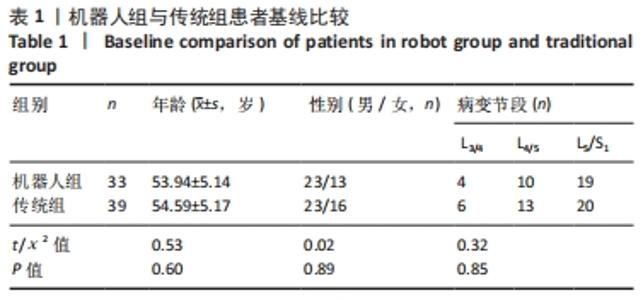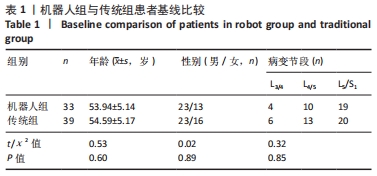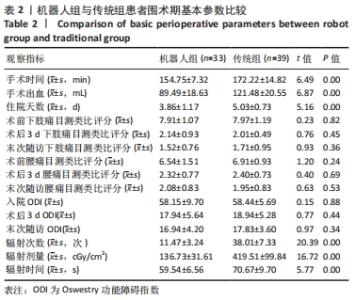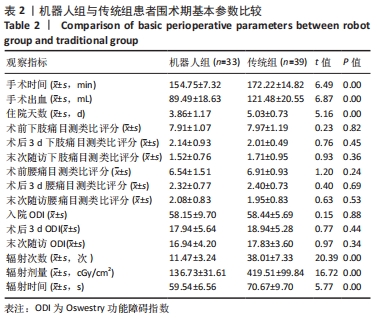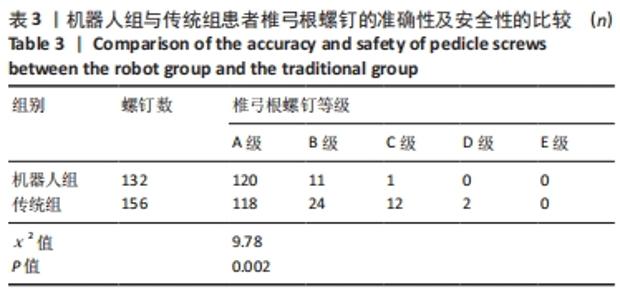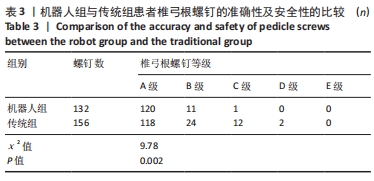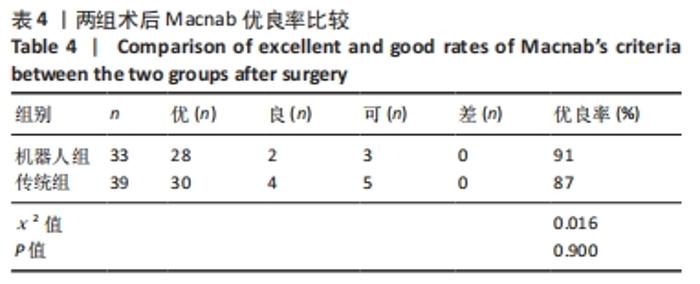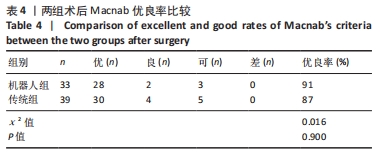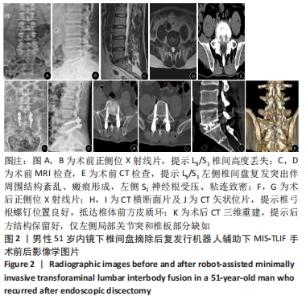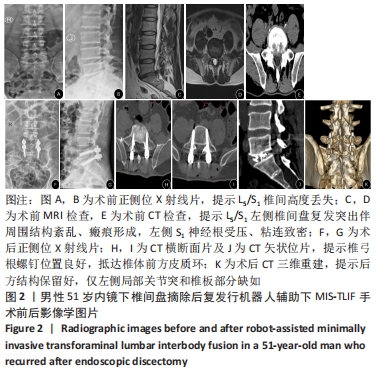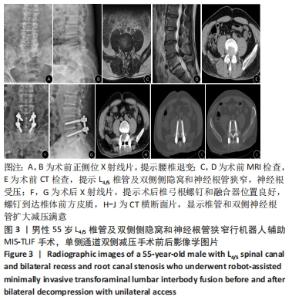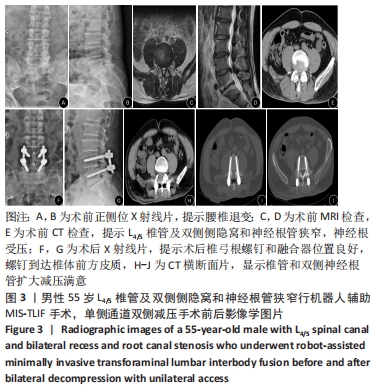Chinese Journal of Tissue Engineering Research ›› 2022, Vol. 26 ›› Issue (36): 5812-5818.doi: 10.12307/2022.974
Previous Articles Next Articles
Robot-assisted minimally invasive transforaminal lumbar interbody fusion in the treatment of lumbar degenerative diseases: accuracy and safety of screw placement
Li Ting1, 2, Liu Xilin1, Wang Fei1, Hu Jiang1
- 1Department of Orthopedic Surgery, Sichuan Academy of Medical Sciences and Sichuan Provincial People’s Hospital, Chengdu 610072, Sichuan Province, China; 2Chengdu Medical College, Chengdu 610500, Sichuan Province, China
-
Received:2021-12-24Accepted:2022-02-16Online:2022-12-28Published:2022-04-27 -
Contact:Liu Xilin, MD, Attending physician, Department of Orthopedic Surgery, Sichuan Academy of Medical Sciences and Sichuan Provincial People’s Hospital, Chengdu 610072, Sichuan Province, China -
About author:Li Ting, Master candidate, Department of Orthopedic Surgery, Sichuan Academy of Medical Sciences and Sichuan Provincial People’s Hospital, Chengdu 610072, Sichuan Province, China; Chengdu Medical College, Chengdu 610500, Sichuan Province, China -
Supported by:Science and Technology Plan Project of Sichuan Province, No. 2021YFS0383 (to LXL)
CLC Number:
Cite this article
Li Ting, Liu Xilin, Wang Fei, Hu Jiang. Robot-assisted minimally invasive transforaminal lumbar interbody fusion in the treatment of lumbar degenerative diseases: accuracy and safety of screw placement[J]. Chinese Journal of Tissue Engineering Research, 2022, 26(36): 5812-5818.
share this article
Add to citation manager EndNote|Reference Manager|ProCite|BibTeX|RefWorks
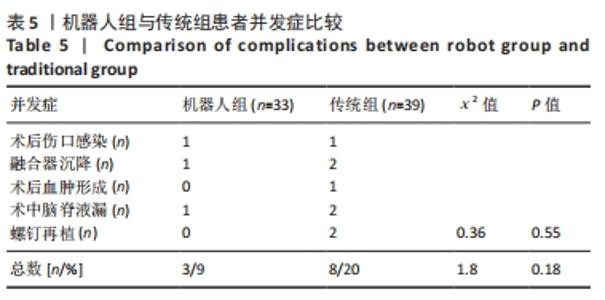
2.6 两组患者并发症比较 机器人组中共计3例有围术期并发症(9%),其中1例为术后伤口感染,1例为影像学融合器沉降[12],椎间隙高度降低超过2 mm,患者无腰腿疼痛临床症状,1例患者术中出现硬脊膜撕裂,术中经全层严密缝合后治愈。传统组共计8例围术期并发症(20%),其中1例为术后伤口感染,1例为切口深部血肿形成,2例发生融合器沉降,出现螺钉位置向头侧超出骨皮质> 4 mm,2例患者因螺钉位置不佳术中即刻行螺钉再次植入,2例患者术中硬脊膜撕裂经全层严密缝合后治愈,所有并发症均在住院期间经有效治疗后好转。并发症的总体发生率两组差异无显著性意义(χ2=1.80,P=0.18),在螺钉重植方面两组差异无显著性意义(χ2=0.36,P=0.55),见表5。"
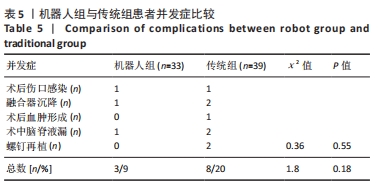
| [1] FOLEY KT, HOLLY LT, SCHWENDER JD. Minimally invasive lumbar fusion. Spine. 2003;28(15 Suppl):S26-35. [2] WANG L, LI H, ZHAO Y, et al. Ligamentum-preserved/temporary preserved minimally invasive transforaminal lumbar interbody fusion (MIS-TLIF) for lumbar spondylolisthesis: technical note and two-years follow-up.Spine (Phila Pa 1976). 2021 Jun 2. doi: 10.1097/BRS.0000000000004136. [3] AO S, ZHENG W, WU J, et al. Comparison of Preliminary clinical outcomes between percutaneous endoscopic and minimally invasive transforaminal lumbar interbody fusion for lumbar degenerative diseases in a tertiary hospital: Is percutaneous endoscopic procedure superior to MIS-TLIF? A prospective cohort study. Int J Surg. 2020;76: 136-143. [4] LEE MJ, MOK J, PATEL P. Transforaminal Lumbar Interbody Fusion: Traditional Open Versus Minimally Invasive Techniques. J Am Acad Orthop Surg. 2018;26(4):124-131. [5] KIM CH, EASLEY K, LEE JS, et al. Comparison of Minimally Invasive Versus Open Transforaminal Interbody Lumbar Fusion. Global Spine J. 2020;10(2 Suppl):143s-150s. [6] LEE KH, YEO W, SOEHARNO H,et al. Learning curve of a complex surgical technique: minimally invasive transforaminal lumbar interbody fusion (MIS TLIF). J Spinal Disord Tech. 2014;27(7):E234-240. [7] KIM MC, CHUNG HT, CHO JL, et al. Subsidence of polyetheretherketone cage after minimally invasive transforaminal lumbar interbody fusion. J Spinal Disord Tech. 2013;26(2):87-92. [8] GERTZBEIN SD, ROBBINS SE. Accuracy of pedicular screw placement in vivo. Spine. 1990;15(1):11-4. [9] HELLER GZ, MANUGUERRA M, CHOW R. How to analyze the Visual Analogue Scale: Myths, truths and clinical relevance. Scand J Pain. 2016;13:67-75. [10] FAIRBANK JC, PYNSENT PB. The Oswestry Disability Index. Spine. 2000; 25(22):2940-2952;discussion 52. [11] MACNAB I. Negative disc exploration. An analysis of the causes of nerve-root involvement in sixty-eight patients. J Bone Joint Surg Am. 1971;53(5):891-903. [12] YAO YC, CHOU PH, LIN HH, et al. Risk Factors of Cage Subsidence in Patients Received Minimally Invasive Transforaminal Lumbar Interbody Fusion. Spine. 2020;45(19):E1279-e1285. [13] SCHUIJT HJ, HUNDERSMARCK D, SMEEING DPJ, et al. Robot-assisted fracture fixation in orthopaedic trauma surgery: a systematic review. OTA Int. 2021;4(4):e153. [14] DU W, SUN T, DING Y, et al. Robot-assisted treatment of unstable pelvic fractures with a percutaneous iliac lumbar double rod fixation combined with a percutaneous pelvic anterior ring INFIX fixation. Int Orthop. 2020;44(6):1223-1232. [15] 姜树东. 机器人辅助MIS-TLIF手术治疗腰椎退行病的初步结果[J]. 中国矫形外科杂志,2020,28(7):586-591. [16] YANG JS, HE B, TIAN F, et al. Accuracy of Robot-Assisted Percutaneous Pedicle Screw Placement for Treatment of Lumbar Spondylolisthesis: A Comparative Cohort Study. Med Sci Monit. 2019;25:2479-2487. [17] YANG J, HAO D, LIU T, et al. Comparison of accuracy between robot-assisted and fluoroscopy-guided percutaneous pedicle screw placement for treatment of lumbar spondylolisthesis. Zhongguo xiu fu chong jian wai ke za zhi. 2018;32(11):1371-1376. [18] GARG B, MEHTA N. Minimally invasive transforaminal lumbar interbody fusion (MI-TLIF): A review of indications, technique, results and complications. J Clin Orthop Trauma. 2019;10(Suppl 1):S156-s62. [19] CHEN X, SONG Q, WANG K, et al. Robot-assisted minimally invasive transforaminal lumbar interbody fusion versus open transforaminal lumbar interbody fusion: a retrospective matched-control analysis for clinical and quality-of-life outcomes. J Comp Eff Res. 2021;10(10):845-856. [20] CUI GY, HAN XG, WEI Y, et al. Robot-Assisted Minimally Invasive Transforaminal Lumbar Interbody Fusion in the Treatment of Lumbar Spondylolisthesis. Orthop Surg. 2021;13(7):1960-1968. [21] ZHAO JX, LI C, REN H, et al. Evolution and Current Applications of Robot-Assisted Fracture Reduction: A Comprehensive Review. Ann Biomed Eng. 2020;48(1):203-224. [22] WU XB, WANG JQ, SUN X, et al. Guidance for Treatment of Pelvic Acetabular Injuries with Precise Minimally Invasive Internal Fixation Based on the Orthopaedic Surgery Robot Positioning System. Orthop Surg. 2019;11(3):341-347. [23] LENER S, WIPPLINGER C, HERNANDEZ RN,et al. Defining the MIS-TLIF: A Systematic Review of Techniques and Technologies Used by Surgeons Worldwide. Global Spine J. 2020; 10(2 Suppl): 151s-167s. [24] Zhao Y, Yuan S, Tian Y, et al. Risk Factors Related to Superior Facet Joint Violation During Lumbar Percutaneous Pedicle Screw Placement in Minimally Invasive Transforaminal Lumbar Interbody Fusion (MIS-TLIF). World Neurosurg. 2020;139:e716-e723. [25] ZHOU LP, ZHANG RJ, LI HM, et al. Comparison of Cranial Facet Joint Violation Rate and Four Other Clinical Indexes Between Robot-assisted and Freehand Pedicle Screw Placement in Spine Surgery: A Meta-analysis. Spine. 2020;45(22):E1532-e1540. [26] RINGEL F, STÜER C, REINKE A, et al. Accuracy of robot-assisted placement of lumbar and sacral pedicle screws: a prospective randomized comparison to conventional freehand screw implantation. Spine. 2012;37(8):E496-501. [27] Yang DS, Li NY, Kleinhenz DT, et al. Risk of Postoperative Complications and Revision Surgery Following Robot-assisted Posterior Lumbar Spinal Fusion. Spine. 2020;45(24):E1692-e1698. [28] FU W, TONG J, LIU G, et al. Robot-assisted technique vs conventional freehand technique in spine surgery: A meta-analysis. Int J Clin Pract. 2021;75(5):e13964. [29] Fatima N, Massaad E, Hadzipasic M,et al. Safety and accuracy of robot-assisted placement of pedicle screws compared to conventional free-hand technique: a systematic review and meta-analysis. Spine J. 2021;21(2):181-192. [30] MODI HN, SHRESTHA U. Comparison of Clinical Outcome and Radiologic Parameters in Open TLIF Versus MIS-TLIF in Single- or Double-Level Lumbar Surgeries. Int J Spine Surg. 2021;15(5):962-970. [31] 张啟维, 张耀南, 孙常太, 等. 计算机导航下椎弓根置钉与徒手置钉的对比[J]. 中国组织工程研究,2013,17(9):1579-1585. [32] LEE JH, JEON DW, LEE SJ,et al. Fusion rates and subsidence of morselized local bone grafted in titanium cages in posterior lumbar interbody fusion using quantitative three-dimensional computed tomography scans. Spine. 2010;35(15):1460-1465. [33] Agarwal N, White MD, Zhang x, et al. Impact of endplate-implant area mismatch on rates and grades of subsidence following stand-alone lateral lumbar interbody fusion: an analysis of 623 levels. Neurosurg Spine. 2020:1-5. doi: 10.3171/2020.1.SPINE19776. [34] BOCAHUT N, AUDUREAU E, POIGNARD A,et al. Incidence and impact of implant subsidence after stand-alone lateral lumbar interbody fusion. Orthop Traumatol Surg Res. 2018;104(3):405-410. [35] SATAKE K, KANEMURA T, NAKASHIMA H,et al. Cage subsidence in lateral interbody fusion with transpsoas approach: intraoperative endplate injury or late-onset settling. Spine Surg Relat Res. 2017;1(4):203-210. [36] CHATHAM LS, PATEL VV, YAKACKI CM,et al. Interbody Spacer Material Properties and Design Conformity for Reducing Subsidence During Lumbar Interbody Fusion. J Biomech Eng. 2017;139(5):0510051-0510058. [37] SHAFI KA, POMPEU YA, VAISHNAV AS, et al. Does robot-assisted navigation influence pedicle screw selection and accuracy in minimally invasive spine surgery? Neurosurg Focus. 2022;52(1):E4. [38] MOHAMMAD-SHAHI MH, NIKOLAOU VS, GIANNITSIOS D,et al. The effect of angular mismatch between vertebral endplate and vertebral body replacement endplate on implant subsidence. J Spinal Disord Tech. 2013;26(5):268-273. |
| [1] | Jiang Huanchang, Zhang Zhaofei, Liang De, Jiang Xiaobing, Yang Xiaodong, Liu Zhixiang. Comparison of advantages between unilateral multidirectional curved and straight vertebroplasty in the treatment of thoracolumbar osteoporotic vertebral compression fracture [J]. Chinese Journal of Tissue Engineering Research, 2022, 26(9): 1407-1411. |
| [2] | Song Jiawei, Yang Yongdong, Yu Xing, Yang Jizhou, Wang Fengxian, Qu Yi, Bi Lianyong. Mid-term effect of Isobar EVO non-fusion dynamic fixation in the treatment of adjacent segment disease after lumbar fusion [J]. Chinese Journal of Tissue Engineering Research, 2022, 26(6): 908-913. |
| [3] | Yang Jun, Yang Qun, Zhang Rui, Jiang Chang. A novel slidable pedicle screw-rod system for lumbar tuberculosis: promoting bone graft fusion by producing stress stimulation to fused segment [J]. Chinese Journal of Tissue Engineering Research, 2022, 26(6): 914-918. |
| [4] | Li Jian, Bao Zhengqi, Zhou Pinghui, Zhu Ruizhi, Li Zhixiang, Wang Jinzi. Effects of posterior single open-door laminoplasty and anterior cervical corpectomy fusion on cervical sagittal balance parameters in the treatment of multilevel cervical spondylotic myelopathy [J]. Chinese Journal of Tissue Engineering Research, 2022, 26(6): 949-953. |
| [5] | Sun Honglei, Qi Fengna, Cheng Ruiqing. ICON penetrating resin for treatment of dental fluorosis: 1-year follow-up [J]. Chinese Journal of Tissue Engineering Research, 2022, 26(34): 5419-5424. |
| [6] | Li Yongwang, Long Yubin, He Rongli, An Ming, Zhang Qian, Qi Hui, Han Zhe, Ma Wenhai. Femoral neck system or combined cannulated screws for femoral neck fracture [J]. Chinese Journal of Tissue Engineering Research, 2022, 26(33): 5329-5334. |
| [7] | Xu Wei, Li Zhifei, Wan Tong, Yu Weibo, Zhang Yisheng, Zhou Jinyan, Bu Xianzhong, Zhong Yuanming. Application of height adjustable titanium fusion cage in endoscopic lumbar fusion [J]. Chinese Journal of Tissue Engineering Research, 2022, 26(33): 5335-5341. |
| [8] | Feng Shuo, Liu Bo, He Da. Effects of robot-assisted percutaneous minimally invasive pedicle screw placement in oblique lumbar interbody fusion [J]. Chinese Journal of Tissue Engineering Research, 2022, 26(3): 408-413. |
| [9] | Jin Herong, Cui Jingbin, Shao Cang. Materials of interbody fusion cage: advantages and focus of clinical application [J]. Chinese Journal of Tissue Engineering Research, 2022, 26(22): 3592-3597. |
| [10] | Zhan Yi, Kang Xin, Wang Yuhang, Zhang Haiping, He Simin, Sun Honghui, Hao Dingjun, Wang Biao. Biomechanical properties of a novel bone cement screw and traditional methods for Kummell’s disease [J]. Chinese Journal of Tissue Engineering Research, 2022, 26(21): 3381-3388. |
| [11] | Yang Xiaoxiao, Xu Yuanjing, Li Wentao, Wang Wenhao, Ma Zhenjiang, Wang Jinwu. Treatment of Achilles tendinitis with an ultrasonic device for emulsification [J]. Chinese Journal of Tissue Engineering Research, 2022, 26(14): 2259-2264. |
| [12] | Yuan Cuihua, Lin Wang, Jiang Yao, Liu Chengzhao. Screw track in computer navigation-assisted percutaneous hollow pedicle screw placement [J]. Chinese Journal of Tissue Engineering Research, 2022, 26(12): 1861-1865. |
| [13] | Xu Lin, Qi Hongshun, Ge Rucun, Li Peipei, Zhen Lixiao, Feng Xiaoya. Effects of minimally invasive surgery combined with metformin on inflammatory responses in rabbits with intracerebral hemorrhage [J]. Chinese Journal of Tissue Engineering Research, 2022, 26(11): 1741-1746. |
| [14] | Yang Xiaoxiao, Xu Yuanjing, Li Wentao, Wang Wenhao, Ma Zhenjiang, Wang Jinwu. Experimental study on treatment of Achilles tendinitis with ultrasound-guided phacoemulsification [J]. Chinese Journal of Tissue Engineering Research, 2021, 25(在线): 1-. |
| [15] | Yao Rubin, Wang Shiyong, Yang Kaishun. Minimally invasive transforaminal lumbar interbody fusion for treatment of single-segment lumbar spinal stenosis improves lumbar-pelvic balance [J]. Chinese Journal of Tissue Engineering Research, 2021, 25(9): 1387-1392. |
| Viewed | ||||||
|
Full text |
|
|||||
|
Abstract |
|
|||||
